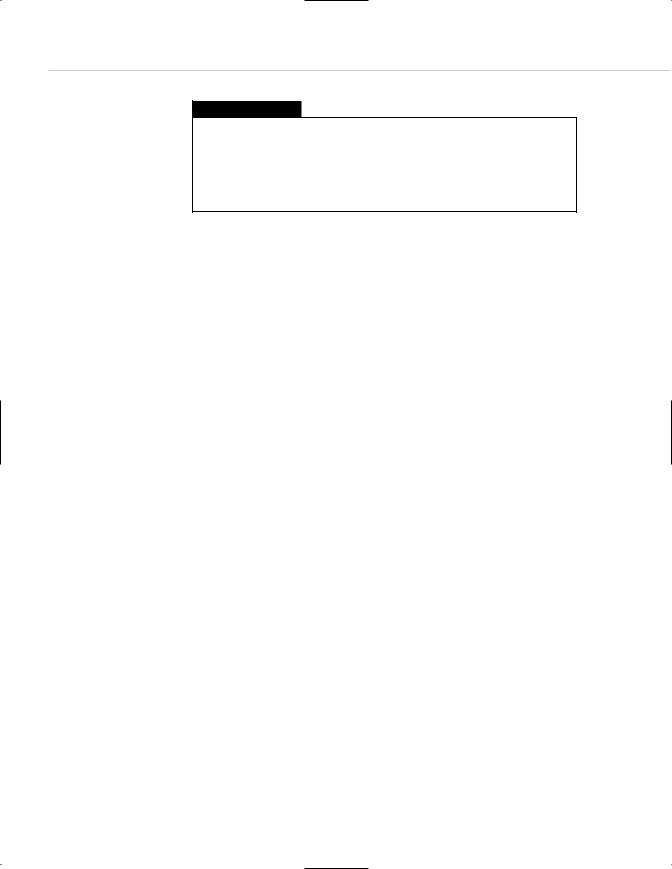
- •Taking Your Talent to the Web
- •Introduction
- •1 Splash Screen
- •Meet the Medium
- •Expanding Horizons
- •Working the Net…Without a Net
- •Smash Your Altars
- •Breath Mint? Or Candy Mint?
- •Where’s the Map?
- •Mars and Venus
- •Web Physics: Action and Interaction
- •Different Purposes, Different Methodologies
- •Web Agnosticism
- •Point #1: The Web Is Platform-Agnostic
- •Point #2: The Web Is Device-Independent
- •The 18-Month Pregnancy
- •Chocolatey Web Goodness
- •’Tis a Gift to Be Simple
- •Democracy, What a Concept
- •Instant Karma
- •The Whole World in Your Hands
- •Just Do It: The Web as Human Activity
- •The Viewer Rules
- •Multimedia: All Talking! All Dancing!
- •The Server Knows
- •It’s the Bandwidth, Stupid
- •Web Pages Have No Secrets
- •The Web Is for Everyone!
- •Swap text and code for images
- •Prune redundancy
- •Cache as Cache Can
- •Much Ado About 5K
- •Screening Room
- •Liquid Design
- •Color My Web
- •Thousands Weep
- •Gamma Gamma Hey!
- •Typography
- •The 97% Solution
- •Points of Distinction
- •Year 2000—Browsers to the Rescue
- •Touch Factor
- •Appropriate Graphic Design
- •User Knowledge
- •What Color Is Your Concept?
- •Business as (Cruel and) Usual
- •The Rise of the Interface Department
- •Form and Function
- •Copycats and Pseudo-Scientists
- •Chaos and Clarity
- •A Design Koan: Interfaces Are a Means too Often Mistaken for an End
- •Universal Body Copy and Other Fictions
- •Interface as Architecture
- •Ten (Okay, Three) Points of Light
- •Be Easily Learned
- •Remain Consistent
- •Continually Provide Feedback
- •GUI, GUI, Chewy, Chewy
- •It’s the Browser, Stupid
- •Clarity Begins at Home (Page)
- •I Think Icon, I Think Icon
- •Structural Labels: Folding the Director’s Chair
- •The Soul of Brevity
- •Hypertext or Hapless Text
- •Scrolling and Clicking Along
- •Stock Options (Providing Alternatives)
- •The So-Called Rule of Five
- •Highlights and Breadcrumbs
- •Consistent Placement
- •Brand That Sucker!
- •Why We Mentioned These Things
- •The year web standards broke, 1
- •The year web standards broke, 2
- •The year web standards broke, 3
- •The year the bubble burst
- •5 The Obligatory Glossary
- •Web Lingo
- •Extranet
- •HTML
- •Hypertext, hyperlinks, and links
- •Internet
- •Intranet
- •JavaScript, ECMAScript, CSS, XML, XHTML, DOM
- •Web page
- •Website
- •Additional terminology
- •Web developer/programmer
- •Project manager
- •Systems administrator (sysadmin) and network administrator (netadmin)
- •Web technician
- •Your Role in the Web
- •Look and feel
- •Business-to-business
- •Business-to-consumer
- •Solve Communication Problems
- •Brand identity
- •Restrictions of the Medium
- •Technology
- •Works with team members
- •Visually and emotionally engaging
- •Easy to navigate
- •Compatible with visitors’ needs
- •Accessible to a wide variety of web browsers and other devices
- •Can You Handle It?
- •What Is the Life Cycle?
- •Why Have a Method?
- •We Never Forget a Phase
- •Analysis (or “Talking to the Client”)
- •The early phase
- •Design
- •Brainstorm and problem solve
- •Translate needs into solutions
- •Sell ideas to the client
- •Identify color comps
- •Create color comps/proof of concept
- •Present color comps and proof of concept
- •Receive design approval
- •Development
- •Create all color comps
- •Communicate functionality
- •Work with templates
- •Design for easy maintenance
- •Testing
- •Deployment
- •The updating game
- •Create and provide documentation and style guides
- •Provide client training
- •Learn about your client’s methods
- •Work the Process
- •Code Wars
- •Table Talk
- •XHTML Marks the Spot
- •Minding Your <p>’s and q’s
- •Looking Ahead
- •Getting Started
- •View Source
- •A Netscape Bonus
- •The Mother of All View Source Tricks
- •Doin’ it in Netscape
- •Doin’ it in Internet Explorer
- •Absolutely Speaking, It’s All Relative
- •What Is Good Markup?
- •What Is Sensible Markup?
- •HTML as a Design Tool
- •The Frames of Hazard
- •Please Frame Safely
- •Framing Your Art
- •<META> <META> Hiney Ho!
- •Search Me
- •Take a (Re)Load Off
- •WYSIWYG, My Aunt Moira’s Left Foot
- •Code of Dishonor
- •WYS Is Not Necessarily WYG
- •Publish That Sucker!
- •HTMHell
- •9 Visual Tools
- •Photoshop Basics: An Overview
- •Comp Preparation
- •Dealing with Color Palettes
- •Exporting to Web-Friendly Formats
- •Gamma Compensation
- •Preparing Typography
- •Slicing and Dicing
- •Rollovers (Image Swapping)
- •GIF Animation
- •Create Seamless Background Patterns (Tiles)
- •Color My Web: Romancing the Cube
- •Dither Me This
- •Death of the Web-Safe Color Palette?
- •A Hex on Both Your Houses
- •Was Blind, but Now I See
- •From Theory to Practice
- •Format This: GIFs, JPEGs, and Such
- •Loves logos, typography, and long walks in the woods
- •GIFs in Photoshop
- •JPEG, the Other White Meat
- •Optimizing GIFs and JPEGs
- •Expanding on Compression
- •Make your JPEGS smaller
- •Combining sharp and blurry
- •Animated GIFs
- •Creating Animations in ImageReady
- •Typography
- •The ABCs of Web Type
- •Anti-Aliasing
- •Specifying Anti-Aliasing for Type
- •General tips
- •General Hints on Type
- •The Sans of Time
- •Space Patrol
- •Lest We Fail to Repeat Ourselves
- •Accessibility, Thy Name Is Text
- •Slicing and Dicing
- •Thinking Semantically
- •Tag Soup and Crackers
- •CSS to the Rescue…Sort of
- •Separation of Style from Content
- •CSS Advantages: Short Term
- •CSS Advantages: Long Term
- •Compatibility Problems: An Overview
- •Working with Style Sheets
- •Types of Style Sheets
- •External style sheets
- •Embedding a style sheet
- •Adding styles inline
- •Fear of Style Sheets: CSS and Layout
- •Fear of Style Sheets: CSS and Typography
- •Promise and performance
- •Font Size Challenges
- •Points of contention
- •Point of no return: browsers of the year 2000
- •Absolute size keywords
- •Relative keywords
- •Length units
- •Percentage units
- •Looking Forward
- •11 The Joy of JavaScript
- •What Is This Thing Called JavaScript?
- •The Web Before JavaScript
- •JavaScript, Yesterday and Today
- •Sounds Great, but I’m an Artist. Do I Really Have to Learn This Stuff?
- •Educating Rita About JavaScript
- •Don’t Panic!
- •JavaScript Basics for Web Designers
- •The Dreaded Text Rollover
- •The Event Handler Horizon
- •Status Quo
- •A Cautionary Note
- •Kids, Try This at Home
- •The Not-So-Fine Print
- •The Ever-Popular Image Rollover
- •A Rollover Script from Project Cool
- •Windows on the World
- •Get Your <HEAD> Together
- •Avoiding the Heartbreak of Linkitis
- •Browser Compensation
- •JavaScript to the Rescue!
- •Location, location, location
- •Watching the Detection
- •Going Global with JavaScript
- •Learning More
- •12 Beyond Text/Pictures
- •You Can Never Be Too Rich Media
- •Server-Side Stuff
- •Where were you in ‘82?
- •Indiana Jones and the template of doom
- •Serving the project
- •Doing More
- •Mini-Case Study: Waferbaby.com
- •Any Size Kid Can Play
- •Take a Walk on the Server Side
- •Are You Being Served?
- •Advantages of SSI
- •Disadvantages of SSI
- •Cookin’ with Java
- •Ghost in the Virtual Machine
- •Java Woes
- •Java Woes: The Politically Correct Version
- •Java Joys
- •Rich Media: Exploding the “Page”
- •Virtual Reality Modeling Language (VRML)
- •SVG and SMIL
- •SMIL (through your fear and sorrow)
- •Romancing the logo
- •Sounds dandy, but will it work?
- •Promises, Promises
- •Turn on, Tune in, Plug-in
- •A Hideous Breach of Reality
- •The ubiquity of plug-ins
- •The Impossible Lightness of Plug-ins
- •Plug-ins Most Likely to Succeed
- •Making It Work: Providing Options
- •The “Automagic Redirect”
- •The iron-plated sound console from Hell
- •The Trouble with Plug-ins
- •If Plug-ins Run Free
- •Parting Sermon
- •13 Never Can Say Goodbye
- •Separation Anxiety
- •A List Apart
- •Astounding Websites
- •The Babble List
- •Dreamless
- •Evolt
- •Redcricket
- •Webdesign-l
- •When All Else Fails
- •Design, Programming, Content
- •The Big Kahunas
- •Beauty and Inspiration
- •Index

276 HOW: Style Sheets for Designers: Trouble in Paradise
The Master List
www.webreview.com/style/css1/charts/mastergrid.shtml
“The mother of all CSS (Cascading Style Sheet) charts,” which lists every aspect of the CSS spec and identifies how well it is supported by various Mac and Windows web browsers.
If the Master List did not convince you (or if you could not quite grasp its meaning), we’ll look at the alternatives one by one:
Font Size Challenges
Among many other capabilities, CSS allows web designers to specify the size of typography on web pages. As shown below, font sizes can be indicated using any of the following: points, pixels, absolute keywords, relative keywords, length units, and percentage units.
H1 {font-size: 14pt}
H1 {font-size: 14px}
H1 {font-size: x-large}
H1 {font-size: larger}
H1 {font-size: 1.5 em}
H1 {font-size: 125%}
Too bad most of the stuff doesn’t work everywhere…yet.
Points of contention
Points are the units of measure with which designers are most familiar— from their years of creating print layouts in Quark XPress or similar programs. Unfortunately, points are meaningless on the Web. Points function as units of print, not as units of screen space. (Pixels are the only meaningful unit of screen space.) Due to platform and resolution differences, 14pt. can mean many things. What it does not mean is a specific unit of screen size.
Points are included in the CSS spec so that designers can set up a second style sheet for printouts, as mentioned earlier in this chapter—one CSS document to control the way the display looks on the screen and a second for printing.

Taking Your Talent to the Web |
277 |
In your print-oriented style sheet (if the browser supports this), it makes perfect sense to use points because printers understand points and can be thrown for a loop by pixels. In some older browsers, 12px type gets printed as 12 pixels, and those pixels are computed against the printer’s resolution. Got a 1200ppi printer? Your 12px type could be .01 inches tall. To avoid that kind of lunacy, points should be used in style sheets devoted to the printer—and nowhere else. (Better browsers recalculate style sheets according to the needs of the printer, but your visitors may not be using these browsers.)
In the world of print, there are approximately 72 points per inch. To match this, Mac OS offers a default resolution of 72 pixels per inch, mapping pixels to points (give or take a fraction). Of course, as soon as the Mac user changes her screen resolution, all bets are off. In Windows and other PC operating systems, there are 96 pixels per inch—until the PC user changes her screen resolution, and then all bets are off.
What this means is that point sizes are incompatible between Mac OS and Windows right from the get-go. For instance, when a Windows client sends a Microsoft Word document to a Mac-based graphic designer, the type is often too small for the designer to read. The same problem traditionally plagued web pages.
Leaving aside the fact that most users change their screen resolution (and therefore all bets are off), savvy developers have used JavaScript to serve appropriate point-size-based style sheets to Mac users versus PC users. It’s more complicated than using pixels, but at least it used to work.
Point of no return: browsers of the year 2000
In IE5/Mac and Netscape 6, this has changed. (See ALA’s “Why IE5/Mac
Matters” for a complete discussion of this issue.)
IE5/Mac sets as its default typographic preference 16px type at 96ppi. In other words, it brings the default Windows typographic resolution to the desktop of Mac users. Netscape 6 does exactly the same thing.

278 HOW: Style Sheets for Designers: Trouble in Paradise
This is not evil hegemony; it is simply common sense in that the more closely browsers adhere to commonalities, the less likely web users are to get hurt. Windows’ default resolution is no better or worse than Mac resolution. But it is the most commonly used resolution, so more sites are designed to accommodate it. Treating it as a de facto “standard” prevents Mac users from being hurt by the poor authoring practices of some web developers.
“Aha!” cries the Scripting Brigade. “So all we have to do is add a few more lines of code to our browser detection scripts, and we can serve Windowssize type to Mac users if they are surfing with IE5 or Netscape 6 and Macsize type if they are using older browsers?”
Not so fast, buckos. IE5/Mac starts at this default resolution but enables users to change it. They can change it back to standard Mac resolution (and how will you know if they’ve done that?). Adept users can change it to a size based specifically on their screen resolution, and Netscape 6 users can change their font size to any arbitrary value that strikes their fancy. You have no way of knowing if they’ve done this or not. Therefore, using JavaScript to detect the user’s browser and platform tells you exactly nothing about their default font size and its relationship to standard point sizes. There is only one thing of which we can be certain: If you use points to control sizes, you are kidding yourself.
What works? Pixels.
Pixels for fun and profit
Though screen resolutions vary, a pixel is always equal to a pixel. Pixels are the only reliable means of sizing typography if the web designer absolutely must control the size of type on the web page. Unfortunately, this practice might cause problems for some readers. For instance, if the designer has specified 10-pixel type:
1.The visually impaired might have difficulty reading the type. This is not a problem in IE5/Mac, which allows users to resize type at their discretion by using the included “text zoom” function. Netscape 6 offers similar functionality, and Opera 5 zooms the entire page at the touch of a button. So in those browsers, you can use pixels without causing accessibility problems for anyone. (But these, as we’ve already explained, are not the most popular browsers.)

Taking Your Talent to the Web |
279 |
2.Older browsers do not allow visitors to resize most CSS type— particularly type set in pixels, and IE5.5/Windows still does not offer text zooming at all. Thus, there will always be a potential accessibility hazard involved when you specify text in pixels—at least until IE for Windows offers text zooming or an equivalent solution. As explained in Chapter 2, we might have to wait 18 months or more for Netscape users to upgrade to the 6.0 browser and for Microsoft to implement text zoom in its Explorer browser for Windows.
3.If your style sheet calls up a scalable True Type font and if the user’s operating system includes that font (and supports True Type), your pixel-based style sheet will work just fine. But if the user’s system does not include a scalable version of that font or a suitable substitute or does not natively include True Type fonts (Linux for example), type set in pixels can display jaggedly and may be illegible.
Accessibility problems are deadly serious. This is not idle, theoretical chitchat. When people can’t read (or even access) your site, it hurts them, it hurts you, and it hurts your clients.
Accessibility problems aside, some designers quibble that pixels are bad because they vary according to screen resolution. A 400 x 400 pixel square
fills most of the screen at 640 x 480, and very little of it at 1600 x 1200.
To which we reply, so what? A 100 pixel–tall CSS headline will be the same height as a 100 pixel–tall GIF image. A 200 pixel–wide CSS div will be equivalent to a 200 pixel–wide JPEG image.
If you intend to create print-like layouts on the web—or even liquid layouts that depend on the relative sizing of elements—you have exactly one choice: pixels. If you can get away with a looser type of design (as you can, for instance, in a personal diary or an academic paper), so much the better. Most of us have to size the elements in our layouts, and most of us designers like it that way.
Besides, our other options simply do not work. For instance:
